Although pozole is a chile-filled concoction often eaten on New Year's Day or Christmas, we're in the throes of soup season.
The chile-infused broth in this slow cooker pozole is enlivened by either verde (green chile) or rojo (red) with pork or chicken. You can use both types of chile, or choose your favorite for this pozole recipe.
You'll love that this recipe is easy, forgiving, and essentially, a one-pot dinner!
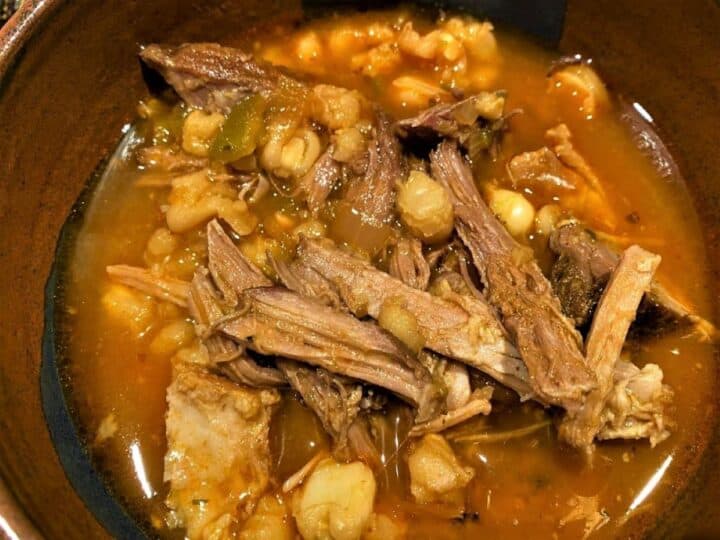
Would you like to save this recipe or article?
You won't get spam from me, I promise!
As an Amazon affiliate, from qualifying purchases at no extra cost to you. Thank you!
Ingredients
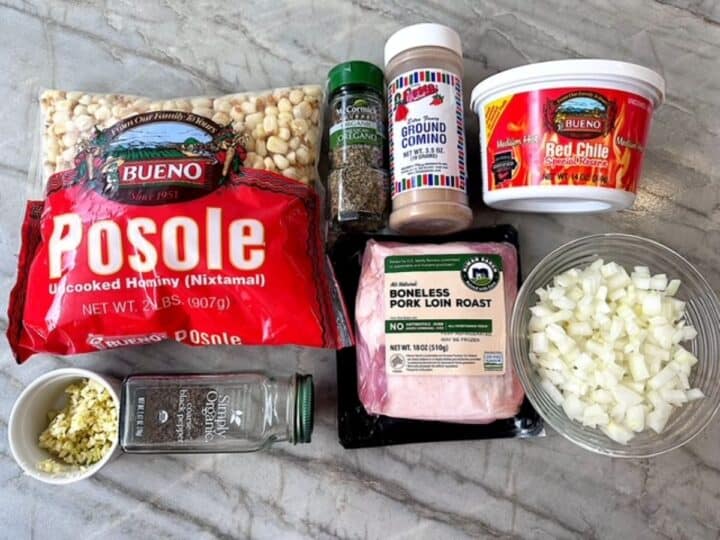
- Pork shoulder (bone-in for best flavor)
- Olive oil
- Hominy corn
- Green chiles, diced
- Onion, diced
- Garlic, minced
- Red chile Bueno frozen or a canned brand
- Cumin
- Oregano, preferably Mexican
- Kosher salt, divided use
- Black pepper, freshly ground
- Limes
- Cilantro, fresh chopped
Pork: Use a bone-in shoulder. It's inexpensive and has some terrific nutrition benefits (see below). Boneless loin roast also works well and is easy to shred.
Hominy corn: Use canned or bagged kernels.
Green and red chile: This recipe tastes great with chile from any source! I've tried fresh green chile grown in New Mexico and (affiliate links) green and red frozen red chile from Bueno Foods. Use mild, medium, or hot chile (if you have an iron stomach.
Onion: Yellow or white. Pick your favorite.
Garlic: You can sub powder, but fresh always has more of a kick.
Cumin: This spice give the pozole that characteristic South of the Border flavor!
Mexican Oregano: (affiliate link) Oregano is a member of the mint family, and this variety has a gutsier flavor.
🍋🟩Limes: The juice of this citrus fruit gives the hearty dish a lift.
🌿Cilantro: A handful of chopped cilantro gives the posole irresistible freshness!
🥘How to make it, slow cooker method
Wash your hands, lathering with soap and rinsing with running water for 20 seconds, before starting.
1️⃣ Sear the pork roast in olive oil, seasoning with a little salt and pepper. Note: This step is optional but will give your posole more flavor.
2️⃣ Spray the slow cooker with non-stick olive oil spray and spread onion over the bottom. Sprinkle garlic over the onion and add the rinsed hominy corn.
3️⃣ Top with the pork and distribute the spices, including salt and pepper, over all ingredients. Squeeze limes over the mixture.
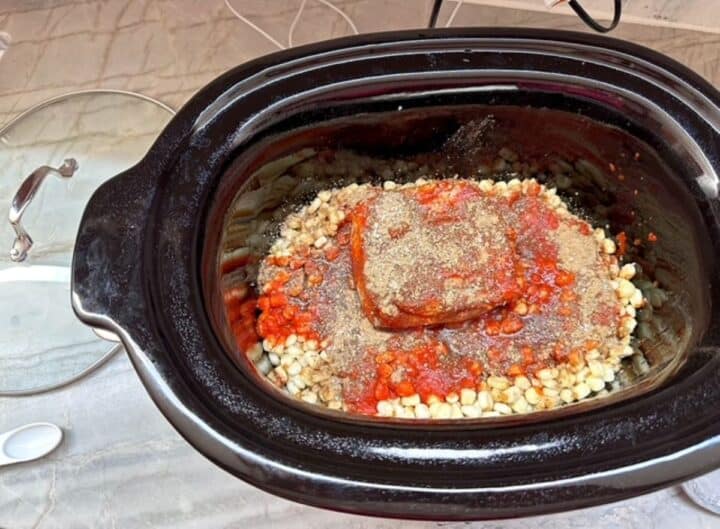
4️⃣ Next, top everything off with an even layer of chile, and pour water to cover over all the ingredients.
5️⃣ Put the lid on, and cook on low for eight hours or high for 6 hours.
6️⃣ When the cooking time is up, fish the pork out of the corn and chiles and shred, removing any bones. Return the meat to the stew and taste for salt.
7️⃣ Top with chopped cilantro and serve in (affiliate link) deep bowls with tortillas and perhaps orange slices on the side.
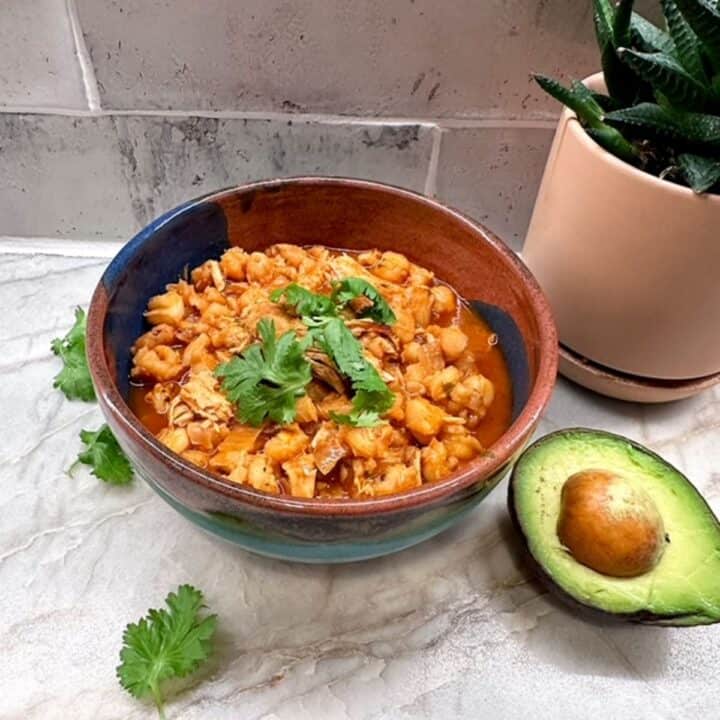
Find the full recipe with amounts and complete instructions at the bottom of this post.
Storage
Pozole will keep in a sealed or covered container in the fridge for three days. After that, freeze the hominy corn stew. It will keep frozen for at least three months and possibly longer.
👀 Check out these (affiliate link) silicone storage containers. Freeze individual portions in them; then, pop out the soup cubes and store them in a plastic bag.
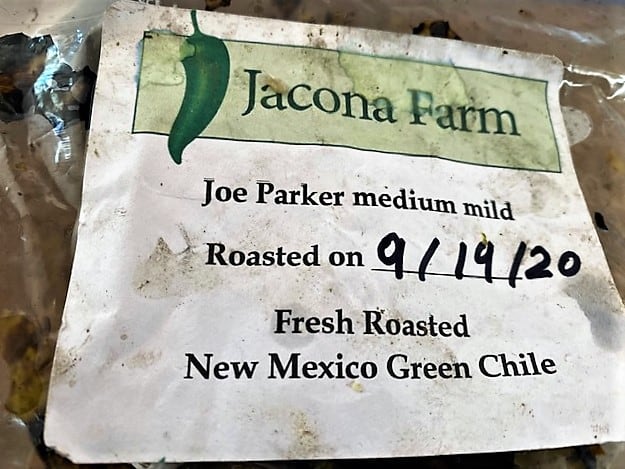
Chile verde (green) sourced locally at the Santa Fe Farmer's Market.
Animal or vegetable? Pozole rojo or verde?
The pork shoulder or bonesless roast will fall into tender shreds at the end of the cooking time, but you don't have to use meat in your pozole. The main requirements are chile and hominy corn.
A vegetarian option would be (affiliate link) soyrizo, which is a plant-based protein that tastes like chorizo.
Many pozole recipes with chicken are also available. Traditionally, chicken pozole features (affiliate link) salsa verde, while red chile is the star of pork pozole. Here's an easy recipe for chicken posole with salsa verde.
Nutrition bone benefits with pork pozole
As mentioned, cooking pozole with bone-in pork adds flavor. Adding a bone to a soup or stew always amps the umami.
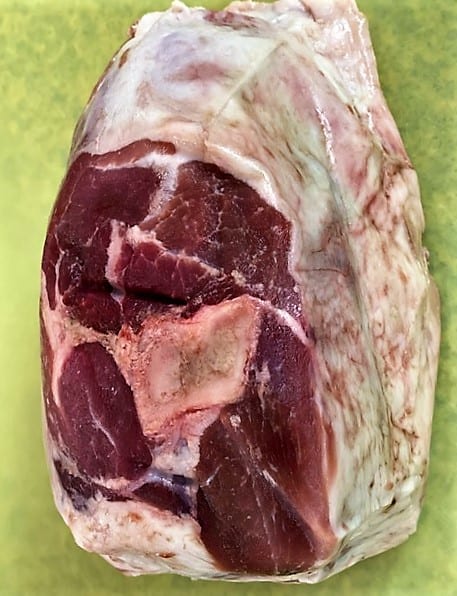
Also, there are nutritional goodies from the bone, cartilage, and connective tissue. You'll add collagen, along with calcium and a slew of other minerals like magnesium and phosphorous.
Check out this video from Practical Dietitians to learn about three important minerals for bone health!
(If you want to know more about how collagen can benefit your joints, skin, and other body systems, read Collagen: 3 or 4 Ways It Keeps a Body Together.)
You'll actually be adding gelatin and its associated amino acids to the soup since collagen becomes gelatin when it is cooked. This is why soups and stocks cooked with bones and animal parts turn jelly-like as they cool.
Maybe you are wondering, "what are these beneficial amino acids, and what makes them so great?" Mainly, they are proline, glycine, and glutamate.

- Proline helps with cartilage and joint repair
- Glycine acts like a neurotransmitter in the brain. It's good for improving sleep.
- Glutamate is also a neurotransmitter, but it has an excitatory function, and it is important for digestion. It endows foods with an umami depth of taste.
Of course, the bone marrow itself contains iron (since this is where your red blood cells start their life).
According to Medical News Today, it boasts many other nutrients:
- Fatty acids
- Vitamins A and K
- Selenium
- Zinc
- Manganese
Pozole soup is not bone broth, but it will have many of the same health benefits as bone broth if you make it with chicken or pork that contains bones.
Before serving, however, remove the meat from the bones. Shred the meat and return it to the soup. This will make for a better eating experience.
(Collagen peptides are a worthwhile supplement. I recommend Vital Proteins, Garden of Life, and Neocell.)
More nutrition bonuses: Hominy corn & nixtamalization
The hominy corn in the soup is a healthy, gluten-free carbohydrate, rich in fiber. Part of what makes hominy so wholesome and so large--it's sometimes called giant corn--is nixtamalization.
Nixtamalization is a process that uses lime, wood ash, lye, or calcium hydroxide to create an alkali soaking solution for the corn that frees up nutrients like niacin (vitamin B3) and eradicates fungi, e.g., mycotoxins. It improves the flavor and aroma of the corn.
Corn soaked in an alkali (like lime juice and water) puffs up, becoming hominy corn.
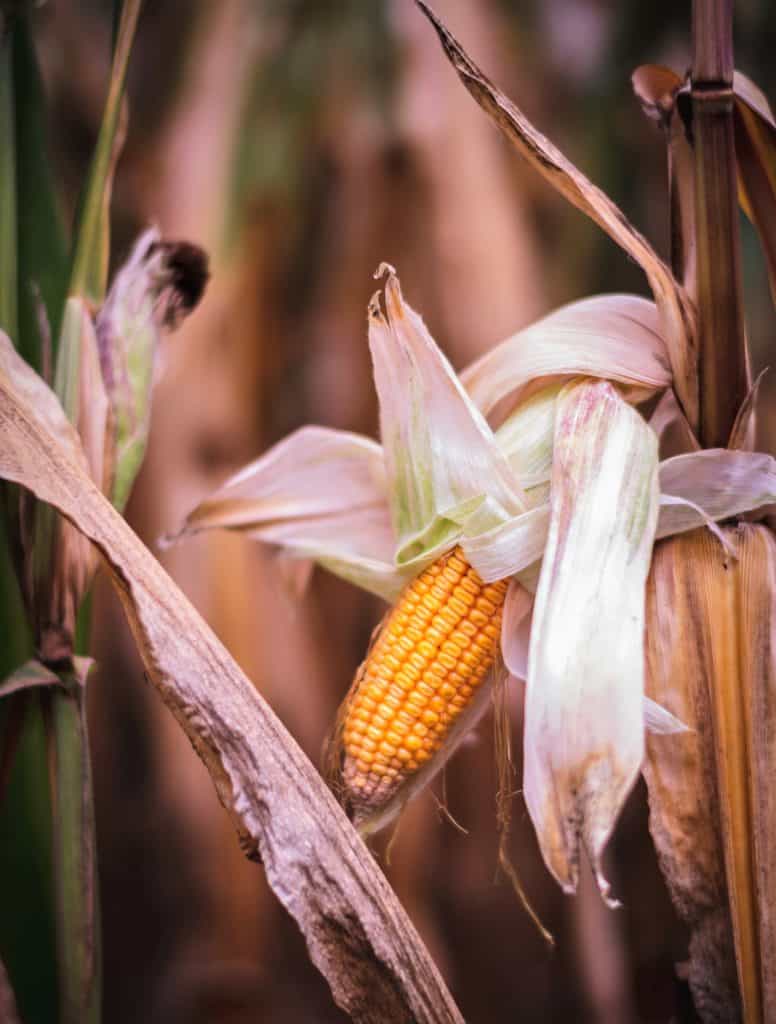
Native peoples in the Americas have used the soaking process for centuries to make their corn more wholesome. They showed European settlers how to make the nixtamalization solution (with wood ash) when they arrived in the U.S.
(The Story of Corn, by Betty Fussell, is an excellent social history of grain and its role in American food culture. You wouldn't expect a book about a commodity to be such a page-turner, but it's a fascinating read.)
Corn tortillas, tamales, tortilla chips, etc. are made from masa dough that uses nixtamal or ground, treated corn. You can find this corn flour or masa harina in many grocery stores.
When populations eat a diet based on corn and don't use nixtamalization, a deficiency called pellagra can develop. It's characterized by the four "D"s: diarrhea, dementia, dermatitis, and death.
Pellagra was common in the southern region of the U.S. in the early part of the 20th century. By the 1950s, the U.S. started to fortify bread and other cereal products with B vitamins.
It's still found in economically disadvantaged parts of Africa and India where corn is a staple food.
Fix pozole for your eating style
Whether you prefer a vegan, vegetarian, or Flexitarian eating experience, pozole is gluten-free and perfect if you or your loved ones have celiac or gluten sensitivity.
Here's an easy vegetarian recipe from the SpruceEats that focuses solely on hominy corn. It doesn't even call for chiles, just chile powder!
Serve this hearty, comforting bowl with corn tortillas on the side for your gluten-free family and friends!
Other soup recipes you might enjoy...
Corn and sausage chowder is a hearty and creamy soup you can make in the slow cooker.
Mushroom and barley soup is easy to put together in the Instant Pot. It takes about 10 minutes longer on the stovetop. Either way, it's a filling vegetarian or vegan meal!
Minestrone di verdure is another vegetarian option that's only slightly less hearty.
Of course, you can add chopped, cooked meat or chicken to either the mushroom barley or the minestrone soups!
Soup season is technically fall and winter, but they are delicious throughout the year and easy when made in the slow cooker!

Red and Green Pozole
Equipment
- Dutch oven optional
- Cutting boards
- Measuring cups
- Large forks
Ingredients
- 2 pounds pork roast bone-in or loin
- 1 Tablespoon olive oil
- 2 pounds hominy corn Bueno fresh hominy corn, or use 2 25-oz cans
- ⅔ cup green chiles diced
- ½ cup onion diced
- 3 cloves garlic minced
- 8 ounces red chile Bueno frozen or a canned brand
- 2 teaspoons cumin
- 1 teaspoon oregano, preferably Mexican
- 1½ teaspoons salt, Kosher, divided use
- ¾ teaspoon black pepper, freshly ground
- 2 Tablespoons lime juice, from 1-2 limes
- 6 cups water, enough to cover the corn and pork
- ¼ cup cilantro, chopped
Toppings:
- avocado, sliced
- cabbage, shredded
- radishes, thinly sliced
- sour cream
Instructions
- Wash hands thoroughly and assemble ingredients.
- Coat the inside of a slow cooker with non-stick olive oil spray to make clean-up easier.
- Heat olive oil over medium-high heat. Pat the pork roast dry. Season with ½ teaspoon of salt and sear on all sides in the hot oil. Be sure to keep raw pork separate from other ingredients and wash hands again after handling.
- Spread the chopped onion over the bottom of the slow cooker. Sprinkle with garlic and top with the rinsed the hominy corn. Place the seared shoulder on top of the vegetables.(If roast is too large to fit comfortably in the slow cooker, slice it in half. Place a half on either side of the cooker. Clean and sanitize the knife used to cut the pork.)
- Cover the pork and corn mixture with chile and then squeeze lime juice over mixture. Add the dry spices, distributing evenly. Add water to cover.
- Put the lid on the slow cooker and set on low for 8 hours or high for 6 hours.
- At the end of the cook time, check the pork for doneness. You should be able to remove it from the bone and shred it easily, even if it is a little firm.
- Return the shredded pieces of pork to the stew and thoroughly combine with hominy corn and other ingredients. Let the stew become piping hot while you prepare the toppings.
- Serve the pozole with warm tortillas, avocado, shredded cabbage, thinly sliced radishes, sprigs of cilantro, sour cream, and lime wedges.
Notes
Nutrition
Copyright © 2021 Jani Hall Leuschel


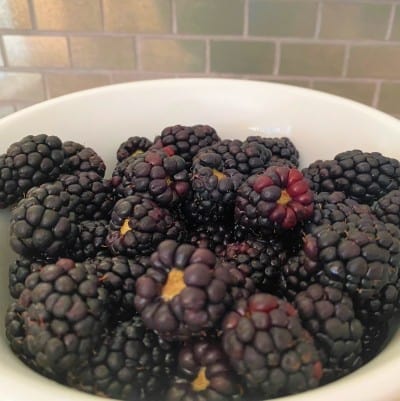
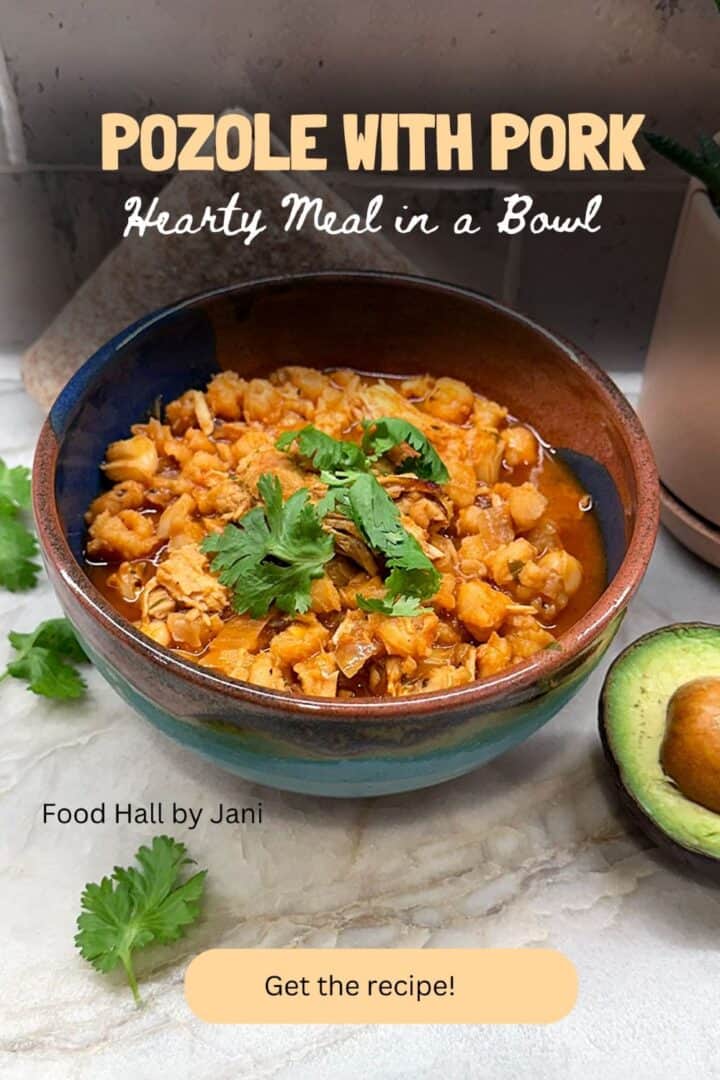


Ruth
Great slow cooker recipe!
Jeff Leuschel
Wonderful idea for a meal that normally is not thought of. Thanks.